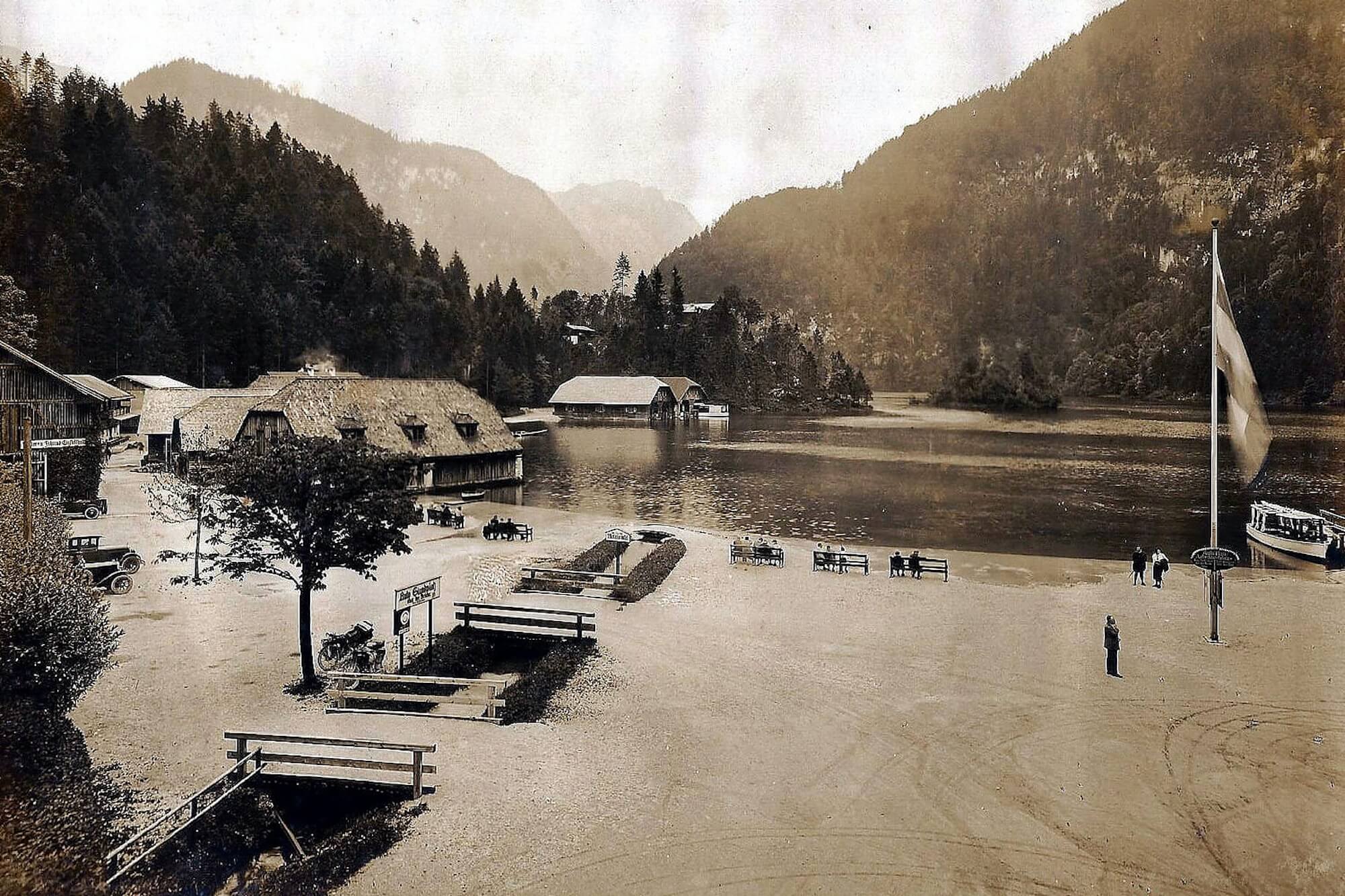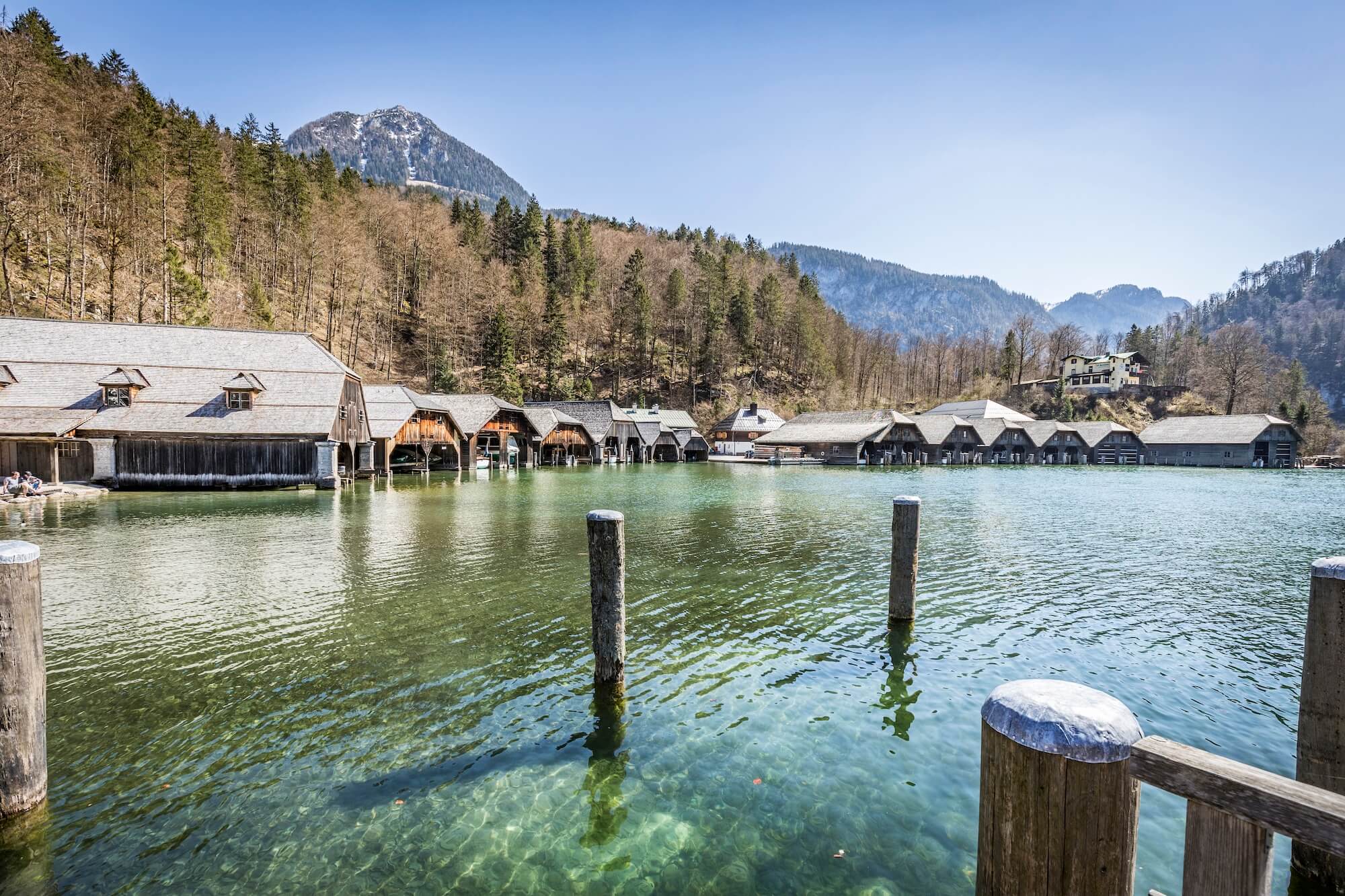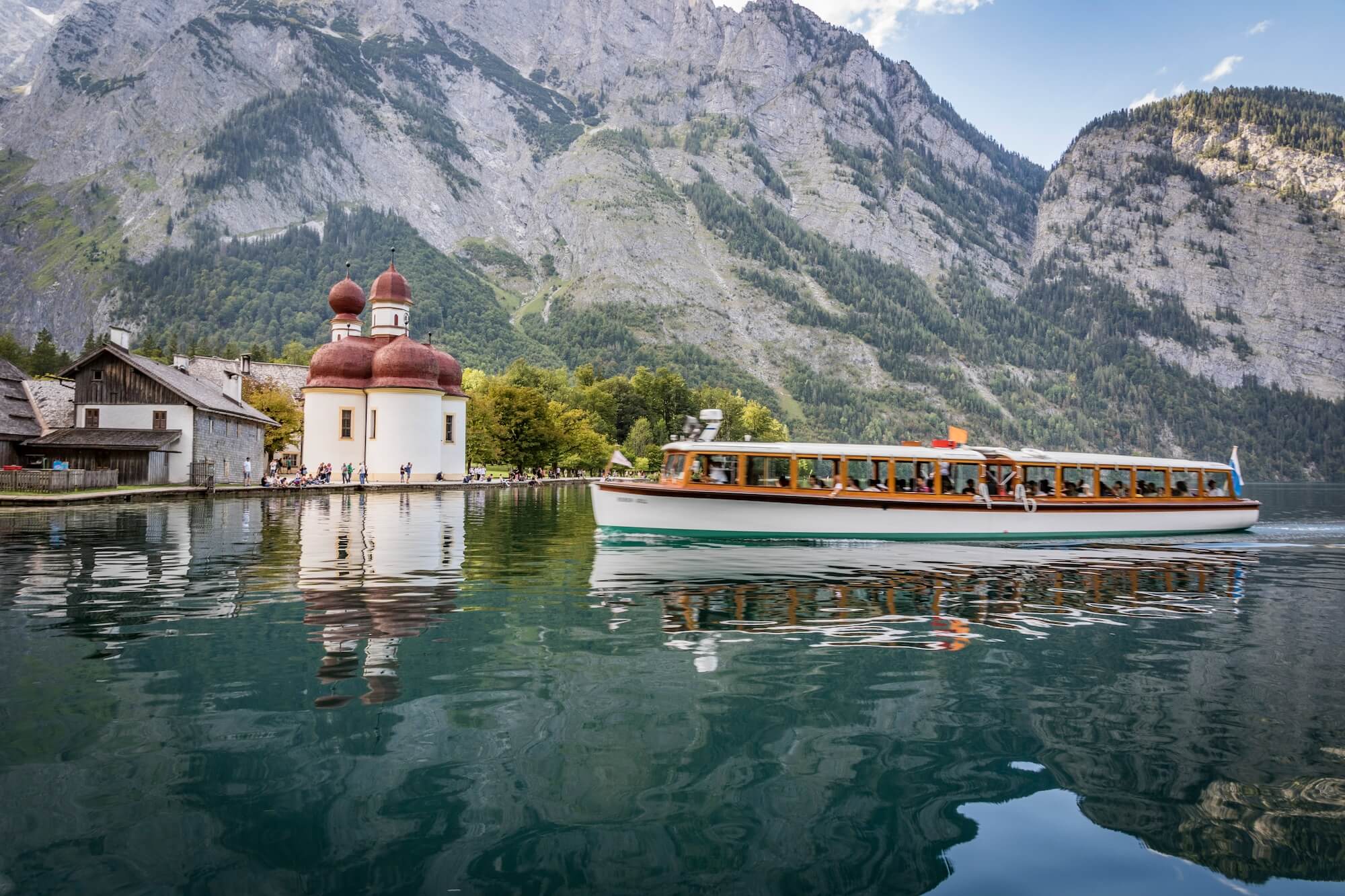
Everything you need to visit Lake Königssee
Discover what most visitors miss during their trip across Lake Königssee with our detailed step by step tour.
From sampling fresh fish at the St Bartholomä chapel, to hearing the famous Echo Wall, use our step by step guide to find out what awaits you on your journey across Lake Königssee.
- 1. The Christlieger Island
- 2. The Sleeping Witch, or Schlafende Hexe
- 3. The Königsbach Waterfall
- 4. The Falkenwand Legend
- 5. The Echo Wall
- 6. Kessel: A hidden stop for keen mountaineers
- 7. A Hike to the Fischunkelalm at Salet
- 8. Salet Stop Dining Recommendation – The Mooskaser
- 9. Salet Stop Photo Opportunities: How to Take the Perfect Shot of Lake Obersee
- 10. Transfer from Salet to the St Bartholomä Peninsula
- 11. A Lakeside Walk to the Rupprechtskaser on the St Bartholomä Peninsula
- 12. An Unforgettable Taste of Lake Königssee: The Fischerstüberl
- 13. Photo Opportunities on the St Bartholomä Peninsula
- 14. Transfer from the St Bartholomä Peninsula Back to Schönau am Königssee
- 15. The Watzmann East Face: King Watzmann and Johann Grill
- 16. Post-cruise dinner suggestion
1. The Christlieger Island
Also known as St John’s island, this spot opposite the main boat piers has hidden powers that should ensure your safe return today. It’s the only island you’ll find on lake Königssee and is home to a statue with a story of secrets to tell.
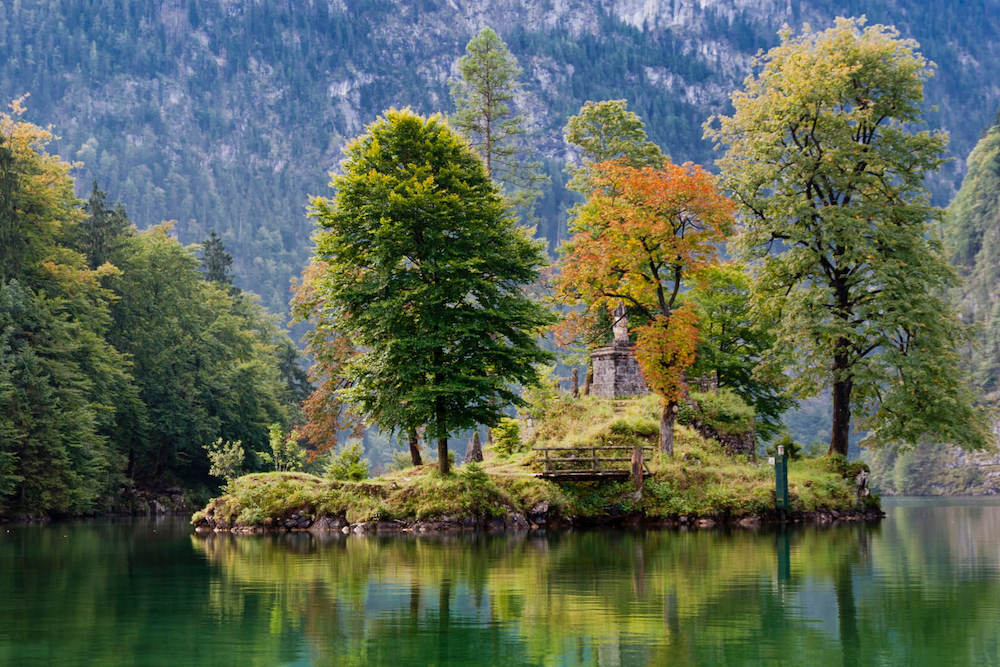
The statue you see on St John’s island (also known as the Christlieger island in German) was built in 1711 by Johann Anton Zeitlmater, a high ranking official from Berchtesgaden. The figure represents the catholic martyr St John of Nepomuk and commemorates the safe return of four passengers involved in a boating accident in 1711 on lake Königssee.
If you’ve travelled throughout Europe, you will have most likely encountered St John. He is easily identifiable thanks to his crown of five stars – the five stars which were said to have hovered over the bridge from which he was thrown into the river Vltava in 1396.
Born in the 1340s, by 1393 St John had been made head of St. Giles Church in Prague. There he is said to have become confessor to Sophia, Queen of Bohemia (now the Czech Republic), who is rumoured to have taken a lover despite being married to King Wenceslaus.
Enduring tremendous pressure from King Wenceslaus to reveal what Sophia had told him, St John is said to have resisted torture before eventually being put to death by the king for his disobedience. He was thrown into the river Vltava in Prague in 1396. His resistance to break the secret of the church confessional quickly lead to him becoming a Catholic Martyr and a saint.
What is less known about St John, and the reason he stands before you here today, is that he is considered the patron saint of boatmen, offering divine protection against flood and drowning.
So, there you have it. An act of defiance in Bohemia over 700 years ago means that you should make it back to land with dry shoes…
2. The Sleeping Witch, or Schlafende Hexe
Once past the Christlieger island take a look behind you at the horizon where you’ll see an unmistakable mountain formation with an uncertain past: the sleeping witch (Schlafende Hexe).
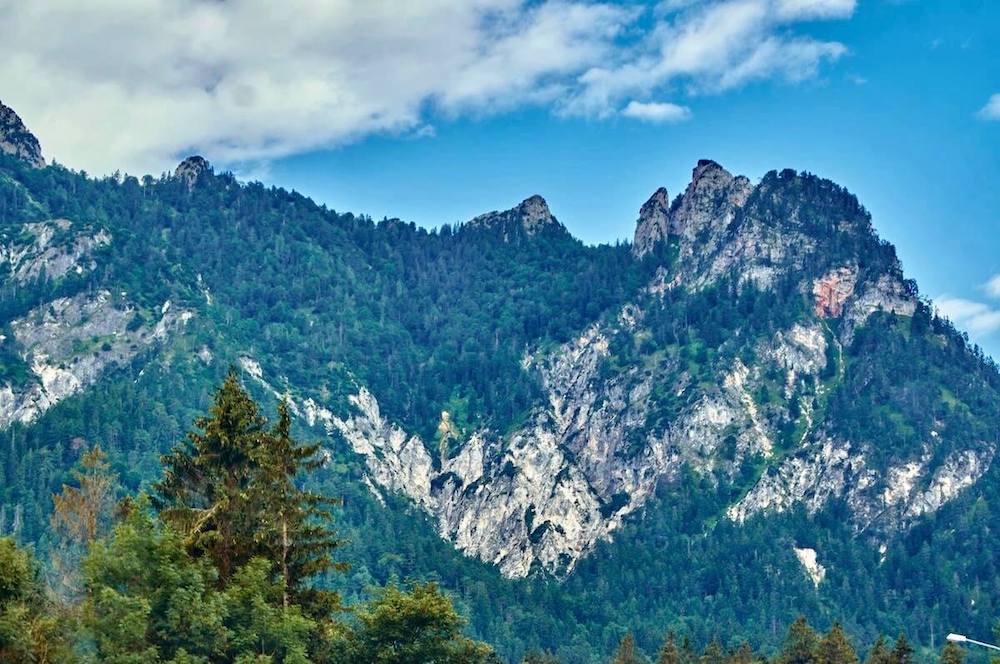
Despite her crisp appearance, the sleeping witch is actually a collection of rocks in the Lattengebirge mountain range. Viewed from the south, they resemble a witch lying on the back, her sharp nose and chin clearly cut out against the skyline.
Many myths and legends surround the sleeping witch, most famous of all suggesting that she is the mother in law of King Watzmann, the once evil ruler of Berchtesgaden.
Other tales suggest she was simply a witch who, more than a thousand years ago, had retired to the mountains as she could no longer stand the valley people.
Legend has it that Martin, a devout Christian on his way to Berchtesgaden, was able to avoid her attacks. When he raised his large crucifix neckless, an earthquake shook the mountains to the sound of a thousand thunder storms. An invisible hand threw the witch to the ground, where she turned to stone and has remained ever since.
Consider the alternative story that reveals the sleeping witch may actually have once been a farm maid. No longer a young lady, and missing a few teeth, she nevertheless worked hard on the dairy farm. As time progressed the old master farmer died and his young son took over the farm. Keen to make his mark, the son worked his staff extremely hard.
On one hot summer’s day cutting the hay, the young farmer had driven his staff so hard that the old maid was forced to lie down to rest in the field. She was completely exhausted. The farmer cursed and threatened her, but the maid had run out of patience for the young hothead, telling him to,” …go to hell, I’ll sleep now!”
And there she still sleeps…
3. The Königsbach Waterfall
Looking to your left as the boat heads out towards the St Bartholomä peninsula you’ll see (and on a still day hear) the Königsbach waterfall. This is one of five major waterfalls that feed into lake Königssee.
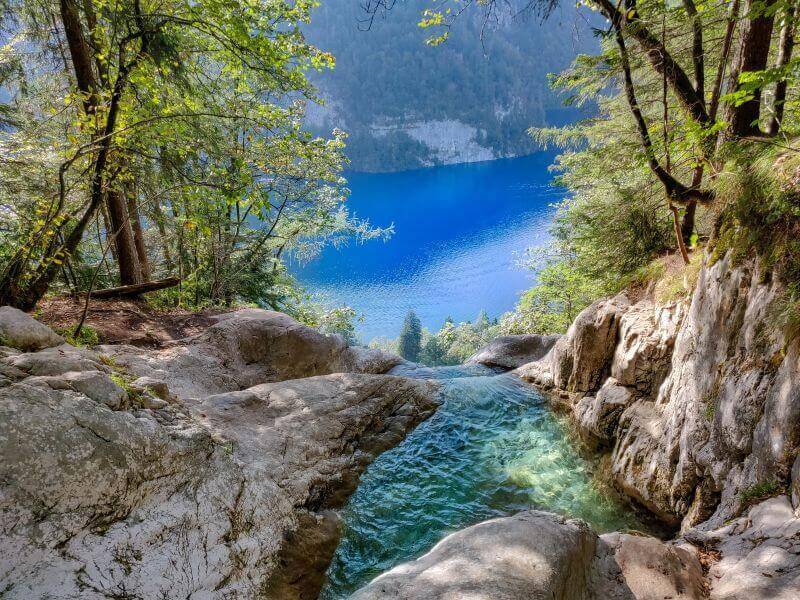
With a drop of around 240m making the Königsbach waterfall one of the highest in Germany, it’s easy to see why it’s also one of the best views of the day.
The waterfall is a natural oasis, well within the protected area of the national park and a beautiful example of the raw power of nature.
Stepped plunge pools have been carved into the rock by the powerful flow of water and snow melt from the Hagengebirge mountains above.
If you look towards to the east side of the lake, you’ll see the mid and higher portions of this rocky waterfall peeping out from behind the lush green pine trees. Many visitors choose to cool off on the hottest days by swimming in the plunge pools. If you look closely, especially if it’s a hot summer’s day, you may be able to see colourful groups of bathers on each step of the waterfall.
4. The Falkenwand Legend
On the opposite side of the lake from the Königsbach waterfall you’ll see a red cross and stone plaque set into the rockface. This wall of rock is known as the Falcon’s Wall (Falkenwand) and can be seen clearly as you cruise towards the chapel of St Bartholomew. A key part of Falkenwand legend is the pilgrimage chapel on the St Bartholomä peninsula, a destination that has attracted religious visitors every August since 1635.
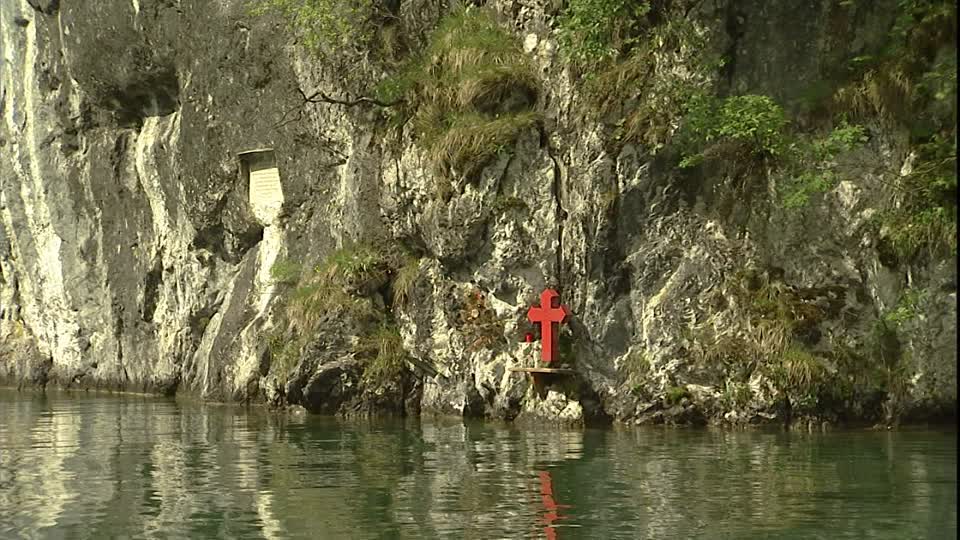
The story goes that during the pilgrimage of 1688, a boat carrying 100 pilgrims encountered a freak storm and crashed into the Falkenwand. Tragically, 70 of the pilgrims drowned before they could be rescued.
Their bodies were recovered and buried at the cemetery in Berchtesgaden and the town erected the red memorial cross and marble plaque that stand as their memorial.
At least, so the story goes… Enter one local Berchtesgaden historian who, some 330 years after the incident, has recently uncovered evidence that challenges this story. Despite there being no records in the German archives, it’s been discovered that the Austrian records of the survivors’ testimonies are still complete and available to view in Salzburg.
The Austrian reports agree that 70 pilgrims were lost. However, they claim that the location of the accident was not the Falkenwand, but actually the shallow waters directly opposite the chapel of St Bartholomew.
And the freak storm?
No mention is made, with the report giving a much less random cause of the accident: negligence. The boat crew, who had been celebrating that day, were sent from St Bartholomew’s chapel to pick up the pilgrims. They refused to make more than one crossing to accommodate the pilgrims. Instead, they insisted that all 100 board the ship together.
The overcrowding caused the ship to overturn just a few moments after leaving for the chapel on the other side of the lake. Rather than a freak storm at the Falkenwand, 70 of the pilgrims instead drowned barely a few hundred meters from the end of their journey.
5. The Echo Wall
As the boat pauses just a few hundred meters past the Falkenwand you’re now looking at a sheer face of rock known as the Echo Wall (Echowand). The Echo Wall is a lake Königssee tradition dating back to the very beginning of tourism in 1909 at this beautiful spot. Today the wall is known for its musical melodies but in the past, it was a much more explosive experience.
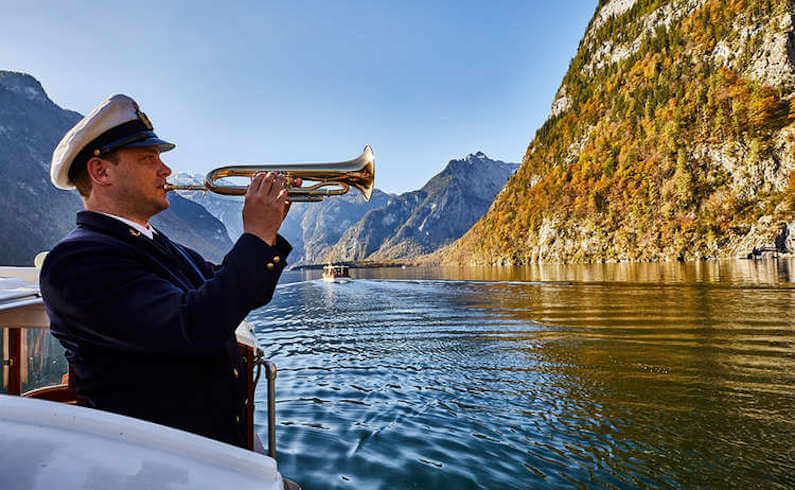
The Echo Wall has been a part of boat journeys on lake Königssee since the electric tourist boats first began cruising. At this unique point, about half way down the lake, the two opposing rockfaces offer perfect conditions to create wonderful echoes.
Boat crews were quick to capitalise on this by taking a black powder pistol with them on trips to fire at the Echo Wall. Here, in the middle of the lake, they would fire at the wall and leave a lasting impression on visitors, with the rockfaces creating up to seven echoes of the initial shot.
Now that the crowd were in high spirits, the crew would pass around a hat for donations in support of the spectacle.
Stowed underneath the steps you used to board the boat today, is the modern version of the black powder pistol once used to demonstrate the Echo Wall: the flugelhorn. The flugelhorn is a traditional German instrument, resembling a trumpet but producing a more mellow tone, and was introduced in the 1930s to replace the black powder pistols.
Instead of terrifying the wildlife in the national park, visitors are now treated to a short performance which bounces off the echo wall and across the waters of the lake up to 3 times. Some traditions remain unchanged, though, with the hat still being passed around for donations after the performance.
Despite over 70 years of using flugelhorn to show off the Echo Wall, it is worth noting that no two performances are ever the same. For starters, the actual piece played will vary according to the boat crew and their tastes. Then there is the weather to consider. A crisp, still winter’s morning will produce a different echo than a summer’s afternoon.
To get the full effect of the echo wall we recommend you sit on the right-hand side of the boat for the journey to St Bartholomew and make sure you are next to a window that you can pull down.
6. Kessel: A hidden stop for keen mountaineers
Looking to the far side of the lake as the hat goes around for tips after the Echo Wall performance, you’ll see the special request stop on lake Königssee – Kessel.
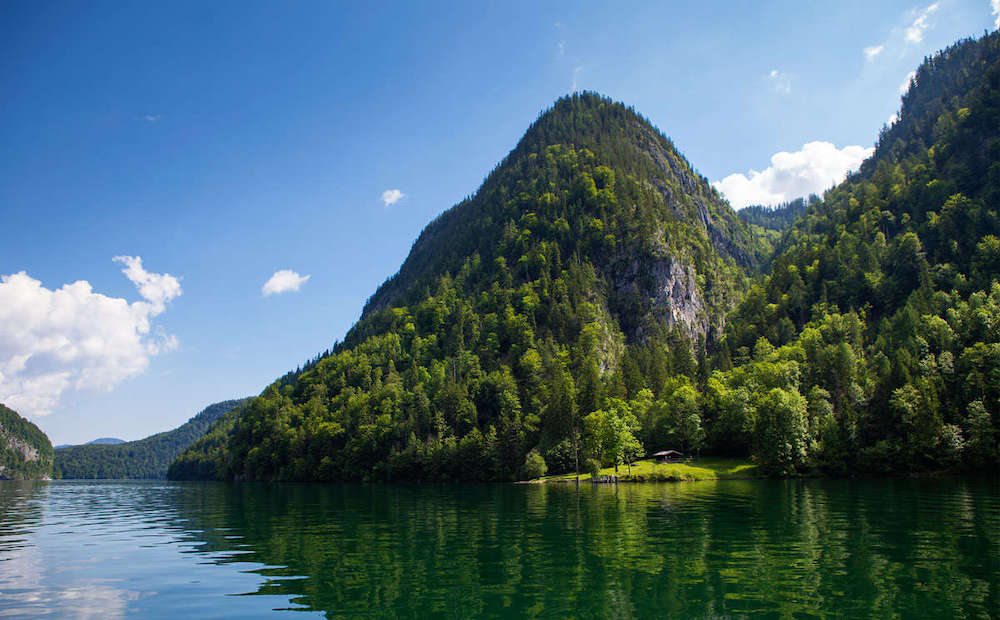
Kessel is a popular stop for hikers. From this point a steep path climbs up to the Gotzenalm meadow at 1685m (5500 feet) and is often the starting point for multi-day hikes in the mountains surrounding lake Königssee.
But Kessel is not a one-way stop. There is also a large sliding signal at the stop for those hikers who want to be picked up. If you look closely on your return journey later today, you may see the fluorescent part of the sliding sign. This is the signal for the captain of the next boat to pick up hikers from the stop.
The Kessel stop was not always just for hikers, though. It’s very first use was actually as a camp for alpine farmers and their cows. The cows would have been sailed across lake Königssee on specially adapted boats and unloaded at the Kessel stop. After an overnight stay, they would then have been led up to their summer pastures high in the mountains.
Later, in 1794, the Wallner brothers from Berchtesgaden set about transforming this location into a tourist garden. Tables, chairs and even a small chapel were built for the use of nature lovers and tourists.
The brothers also created a small pathway into the Kessel canyon, following the Kessel stream. Here visitors could enjoy wooden walkways, a small bridge and steps carved into the stone and see the two waterfalls at the centre of the canyon.
The canyon, however, was not stable and ended the brothers’ dream sooner than they expected. Huge rockfalls blocked the path. They became and still are a deadly risk to visitors.
Not all of the brothers’ efforts were in vain, though. Some relics remain on the peninsula, among them a memorial stone which can still be seen at the stop today.
At this point the boat will call at the St Bartholomä peninsula. It’s advisable to stay on the boat and head to the Salet (for lake Obersee) stop first to get ahead of the crowds.
7. A Hike to the Fischunkelalm at Salet
Once you’ve landed at the Salet stop we recommend cracking on with a hike to the other side of lake Obersee, arguably one of the most secluded spots in the Berchtesgaden Alps.
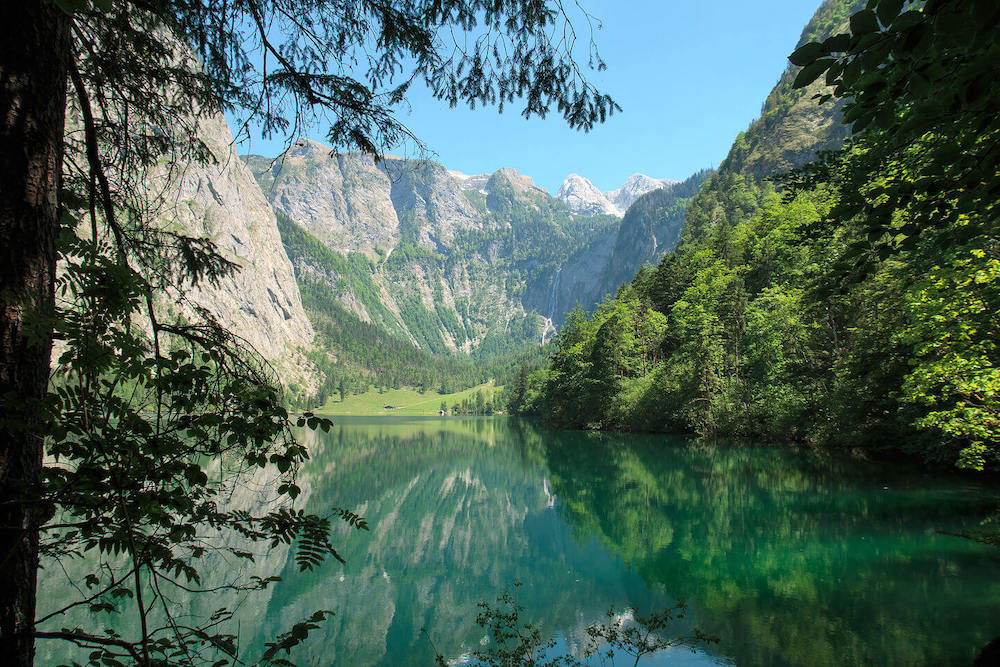
Please note that this walk includes a rocky path along the side of the Obersee lake, which whilst maintained by the National Park is dangerous and very slippery when wet.
Please do not attempt this walk unless you are in good physical condition, have hiking shoes on and are comfortable with heights. We do not recommend this walk for children under 14.
The best WC/restroom facilities are in the wooden ticket complex opposite the pier and even include baby change and step free accessible WCs. One ready, head along the shore path past the ticket & WC buildings towards the self-service restaurant Gaststätte Saletalm.
The stretch of path from the pier to the shore of lake Obersee is maintained by the national park to ensure an easy journey for those who use a wheelchair.
At the restaurant, continue straight ahead on the main path past the giftshop stand. Continue straight ahead and do not take the right-hand turn marked zur Almhütte.
After around 25 minutes of walking you will arrive at the west shore of lake Obersee, with its picture-perfect authentic Bavarian fisherman’s boathouse. At this point the wheelchair friendly path finishes.
For those following the path right all the way to the Fischunkelalm, we now wind along the west shore of the lake, and then climb the rocky path to go along it’s south edge. Hugging the rock and using the steps and handrails will eventually bring you safely to the far side of lake Obersee. Well done! Or in German, gut gemacht!
You now need to follow the short path to our left along the edge of the lake to reach the Fischunkelalm. Half way along this path is another lovely fisherman’s boat shed – an excellent photo opportunity. At the end of this lakeside path you’ll finally find the Fischunkelalm and the opportunity to order a well-deserved drink or snack.
8. Salet Stop Dining Recommendation – The Mooskaser
Our dining tip is the hidden gem of the Salet stop: the Mooskaser. Being a functional farming hut it’s of very humble origins, most likely pre-dating the main guest house (Alpengaststätte Saletalm) and by no means commercialised. Even on a busy summer’s day in August, you can rest assured that you’ll have somewhere to sit and limited crowds here owing to the Mooskaser’s positioning well off the beaten track.
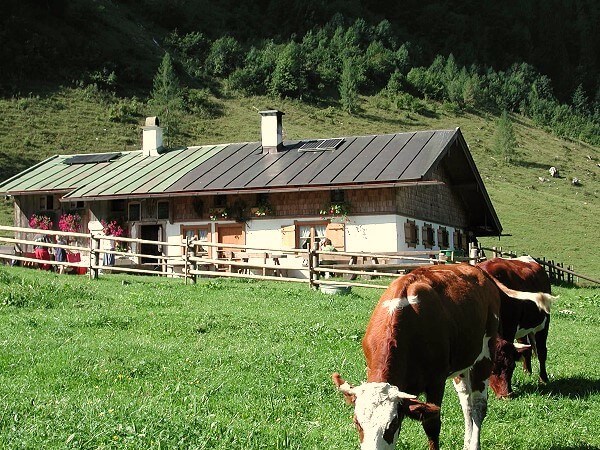
To reach the Mooskaser, simply follow the path leading along the shore of the Königssee from the boat pier, past the main guest house (signed Alpengaststätte Saletalm) before then turning right at the crossroads, where a yellow sign directs you right “Zur Almhütte”, with the Mooskaser visible in the distance.
Whilst relaxing in the guest garden of the Mooskaser you’ll be treated to an unparalleled view over the Königssee and your own heard of alpine cows for company just over the fence.
It’s the unspoilt grazing and luxurious milk produced by these cows that means the Mooskaser is able to offer some of the freshest and finest dairy products in the region, with the menu offering a delightful selection of traditional home-made milk, buttermilk, cheeses and breads. If that’s not enough to tempt you, the kitchen also serves delicious home-made cakes to make sure you’re set up for your return voyage.Our recommendation: A glass of buttermilk with a shot of elderflower syrup (ein Glas Buttermilch mit einem Schuß Holunderblütensirup in German).
9. Salet Stop Photo Opportunities: How to Take the Perfect Shot of Lake Obersee
Lake Obersee is a photographer’s paradise, offering the chance to capture gorgeous shots of one of the most unspoilt lakes in the Alps. This spot also gives you the chance to photograph the highest waterfall in Germany and a surprisingly symmetrical natural rock-basin.
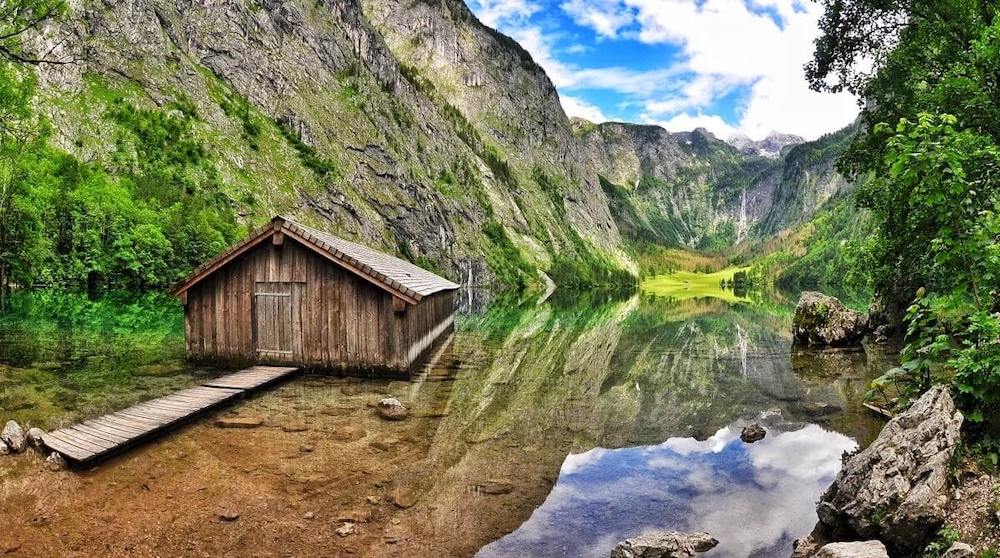
The reason lake Obersee lends itself so well to photography is the remote nature of the spot. You’ll slowly encounter fewer and fewer visitors as you make your way through this magical place. We suggest you take one of the first boats of the day to get the clearest shots.
Once you’ve stepped off the boat at the Salet pier, head along the shore path towards the self-service restaurant called Gaststätte Saletalm. Continue ahead on the main path past the restaurant, signposted Fischunkelalm and Röthbach Wasserfall. Do not take the right-hand turn marked “zur Almhütte”.
The path will take you past the small middle lake (called Mittersee in German) and after 10 minutes you will arrive at a truly magical photo opportunity: the boathouse on the west shore of lake Obersee.
Here you will encounter an authentic Bavarian fisherman’s shed and the most stunning of backdrops.
The waters of lake Obersee are so pure that they are able to produce some of the most perfect reflections you’ll likely ever see. Far in the distance you also have the Röthbach waterfall to complete this shot.
For selfie-lovers the pier in front of the boat shed offers a standout spot to grab your selfie-stick and put yourself in the picture.
If the area around the boathouse is too crowded it’s worth following the path along the shore of the lake to the south, since there are many rocks at the lake’s edge which also share this jaw-dropping background.
The architectural features and furnishings of this space were designed to convey a sense of grandeur and timeless power, a message that fitted well with Hitler’s vision of creating a new empire that would mimic those of Charlemagne and Bismark before him.
With this in mind, it’s easy to appreciate that the Great Hall is something of a stage, designed not only to convey the idea of a hall befitting the new thousand-year kingdom, but, with its thick granite-clad walls, huge oak ceiling beams and imposing red marble fireplace, a space to impress and intimidate visitors.
10. Transfer from Salet to the St Bartholomä Peninsula
When you’re ready to visit the St Bartholomä peninsula, head back to the pier where you got off the boat earlier and line up on the side marked for St Bartholomä.
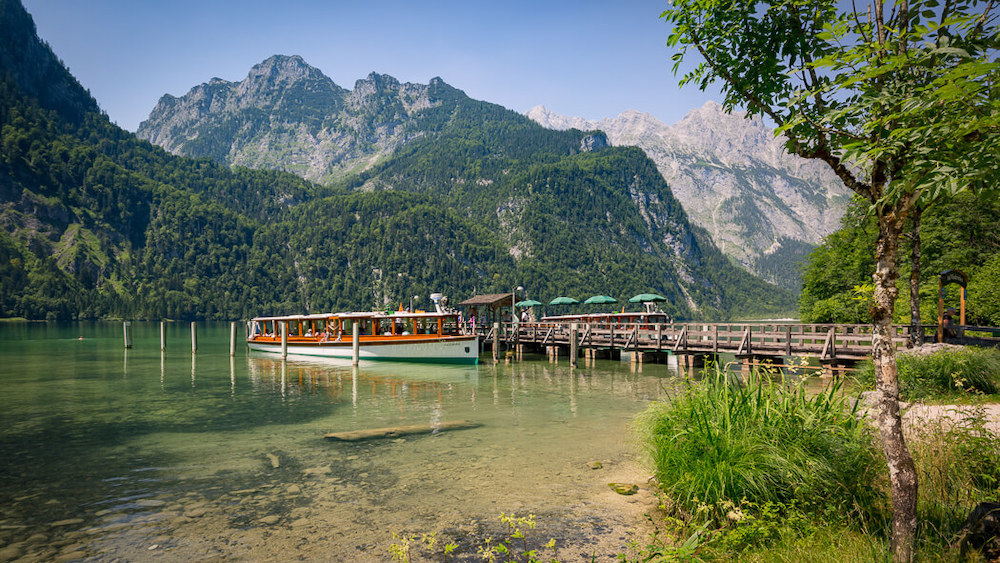
If you’re lucky a boat will be boarding, but the worst-case scenario is a wait for 15 minutes or so for a boat to arrive.
11. A Lakeside Walk to the Rupprechtskaser on the St Bartholomä Peninsula
Once you arrive at the St Bartholomä peninsula we recommend a lakeside walk to the Rupprechtskaser – a favourite of the Bavarian Royal family and one of the most picturesque paths of the entire St Bartholomew peninsula.
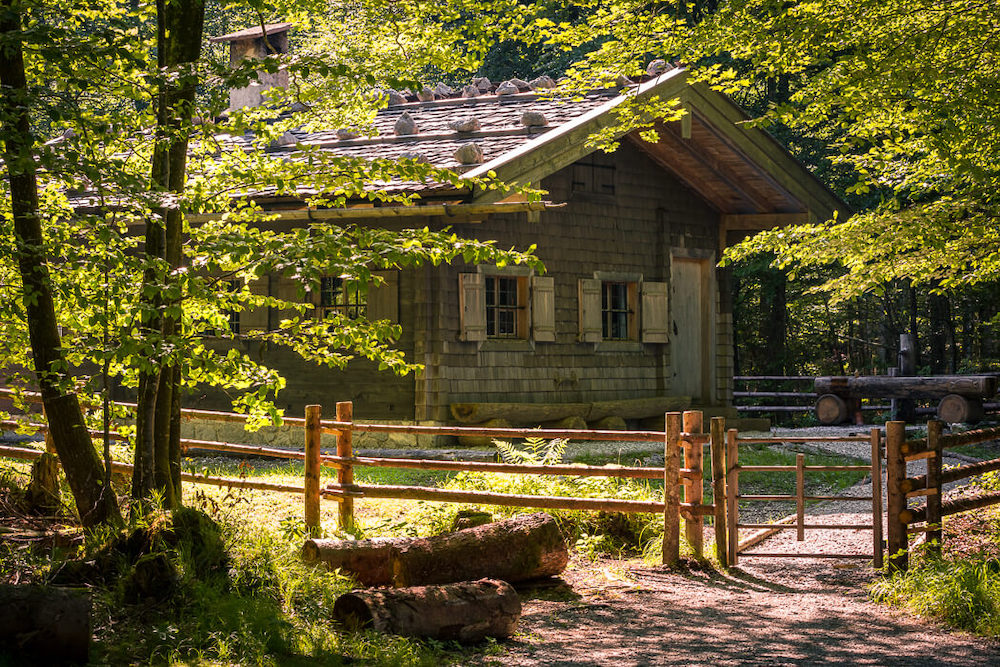
This walk takes approximately 60 minutes. The path is flat and the first half is suitable for wheelchair users and pushchairs/prams/strollers.
The Rupprechtskaser was a small hunting hut built in the early 1900s by King Rupprecht of Bavaria. He built it for his wife, Marie Gabrielle, Duchess of the counties of Cornwall and Rothesay in the United Kingdom. This building and special spot overlooking lake Königssee were a family favourite, with the couple’s sons (Prince Luitpold and Prince Albert) also spending time here.
The Rupprechtskaser remains largely unchanged today and on the shores of lake Königssee you’ll also find a memorial to Marie-Gabrielle, who died tragically in 1912 aged just 34.
We start our journey under the red domes of St Bartholomew’s chapel, where our route makes its way north along the shore of the lake. This stretch is maintained by the national park to ensure an easy journey for those who use a wheelchair.
Wonderful views across the lake open up before you and on warmer days you’re sure to see brave bathers enjoying the water. Ignore the first left hand signpost to the tourist information hut and continue along the lakeside, also ignoring the second left-hand turn option and heading straight on again.
After about 800m (900 yards) of what is arguably the most beautiful footpath of the peninsula, you’ll arrive at the Rupprechtskaser hut and the lake-side memorial to Princess Marie-Gabrielle. The memorial reads:
“To the memory of the noble princess Marie-Gabrielle of Bavaria 1912“
The further north along the path you go the more secluded it gets, and there are plenty of benches for you to rest your feet and soak up the views.
About 100 meters (300 feet) after the Rupprechtkaser you arrive at another yellow signpost, where you now do need to turn left. At this point the wheelchair friendly path finishes and those with wheelchairs/prams/pushchairs/strollers will need to return to the chapel along the path used to reach the Rupprechtkaser.
For those continuing with the loop, the flat path continues, and you now turn left and head along a part of the path network that is surrounded by dense forest. This section is particularly beautiful in both summer and winter, with the impressive east face of the Watzmann mountain rising above the treeline in the background.
Avoid taking the right-hand turn whilst on this path and continue straight ahead for around 500m (1500 feet), where you arrive at a T-junction. Here you need to turn left and head back towards the chapel complex to complete our loop.
On this final stretch of path, a visit to the tourist information centre is well worth it to learn more about what lives and grows in the forest here. On cold days they might even have the authentic Bavarian Kachelofen (a tiled stove) burning…
12. An Unforgettable Taste of Lake Königssee: The Fischerstüberl
After a decent walk to the Rupprechtskaser (and maybe even a swim), now’s the perfect time to sample some of lake Königssee’s finest produce. The Fischerstüberl (fisherman’s inn) is one of lake Königssee’s best kept secrets, however most visitors pass it by during their visit to the St Bartholomew peninsula.
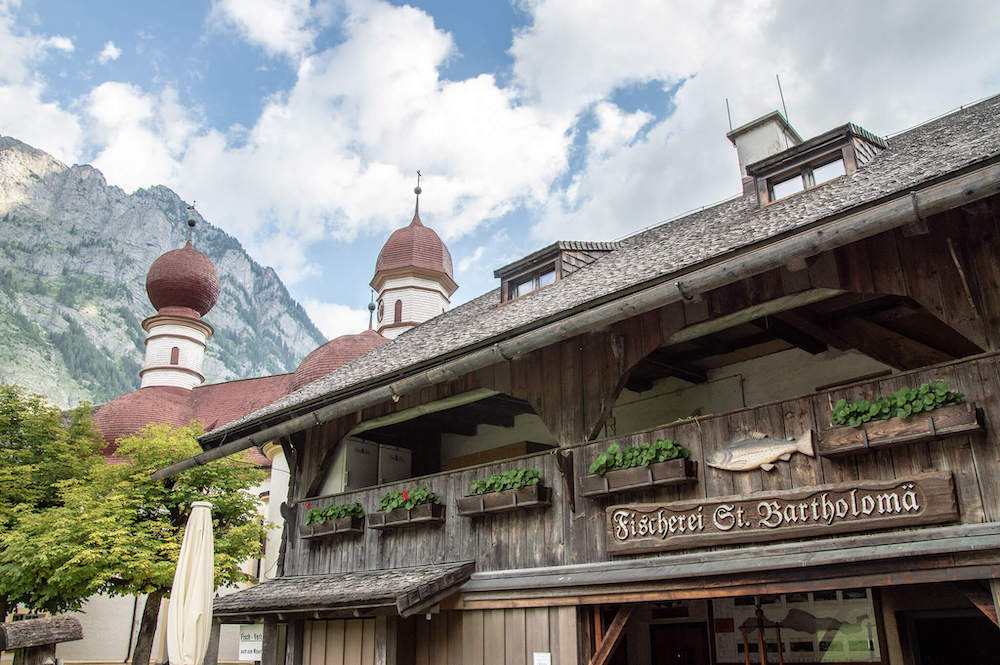
Just to the right-hand side of the chapel, the brown timber building that houses the Fischerstüberl is easy to miss but in fact well over 400 years old. To find it, simply follow your nose towards the smells of beech, ash and maple woods smoking the freshly caught fish.
Here Thomas Amort, who has been fishing on lake Königssee since 2008, manages the family business. He is the third generation of the Amort family to fish on the lake.
Fishing on lake Königssee is an old tradition. Thomas Amort follows in the footsteps of his father, Rudolf, whose fishing career here lasted from 1967 to 2008. You can see one of Rudolf’s most famous catches in the fisherman’s showcase outside the Fischerstüberl: a mighty 28Kg (55lb) trout caught in 1976.
The highlight of the menu – and our recommendation – is the Schwarzreiter. These small char (similar to salmon) are smoked on thin, wooden skewers over a hazelnut wood fire to give a wonderful flavour. This process has been passed from generation to generation of the Amort family and is practised exclusively here at lake Königssee.
As well as the char (Saiblinge in German), you can also try trout (Forellen) and whitefish (Renken) at the Fischerstüberl, all served on characterful wooden platters with oven-fresh pretzels and dark rye bread.
Guten Appetit! (German for “enjoy your meal”)
13. Photo Opportunities on the St Bartholomä Peninsula
Undoubtedly the most impressive angle of St Bartholomew’s Chapel is that you see when you approach or depart by boat. From this direction the crisp, wine-red domes align with the rugged sight of the Watzmann mountain behind. With the reflective waters of lake Königssee below, this makes for a beautiful picture in all seasons and light levels.
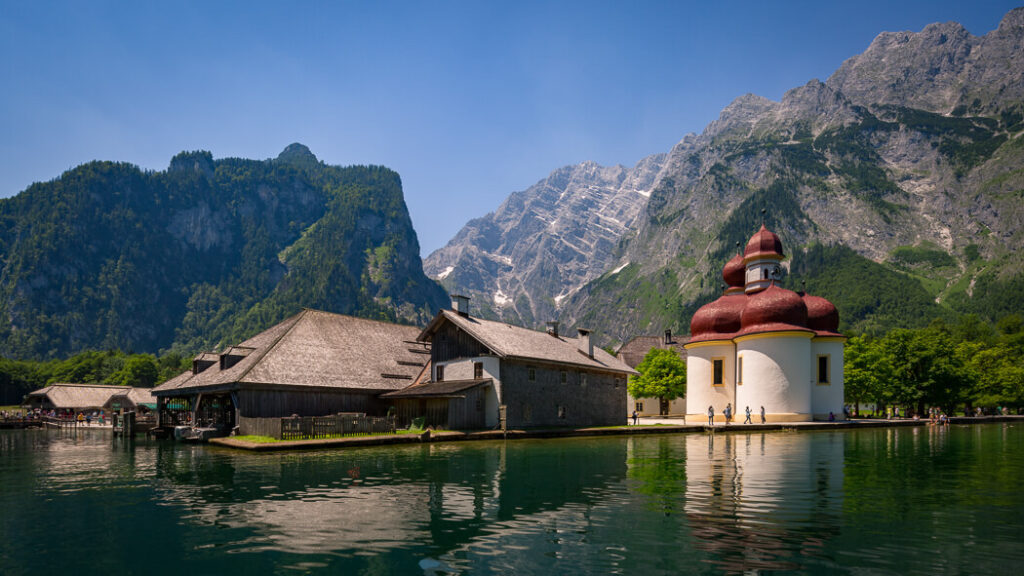
Once you have your feet on dry land, we recommend the pathway from the pier to the chapel as the best opportunity to capture the hunting lodge, chapel and surroundings with an impressive mountain backdrop.
Those armed with a selfie-stick will be rewarded if they walk over to edge of the lake opposite the chapel. Here there is a stunning backdrop of symmetrical mountain walls – the perfect background for your photo.
If you’re after a selfie with the chapel, head back to the pier where (crowds permitting) there is a “St. Bartholomä” sign in a wonderfully authentic hand-painted German font with the chapel and hunting lodge in the background. Stand yourself beside the sign and snap away!
14. Transfer from the St Bartholomä Peninsula Back to Schönau am Königssee
When you’re ready to leave the St Bartholomä peninsula, head back to the pier where you got off the boat earlier and line up on the side marked for Schönau am Königssee, NOT for Salet/Obersee.
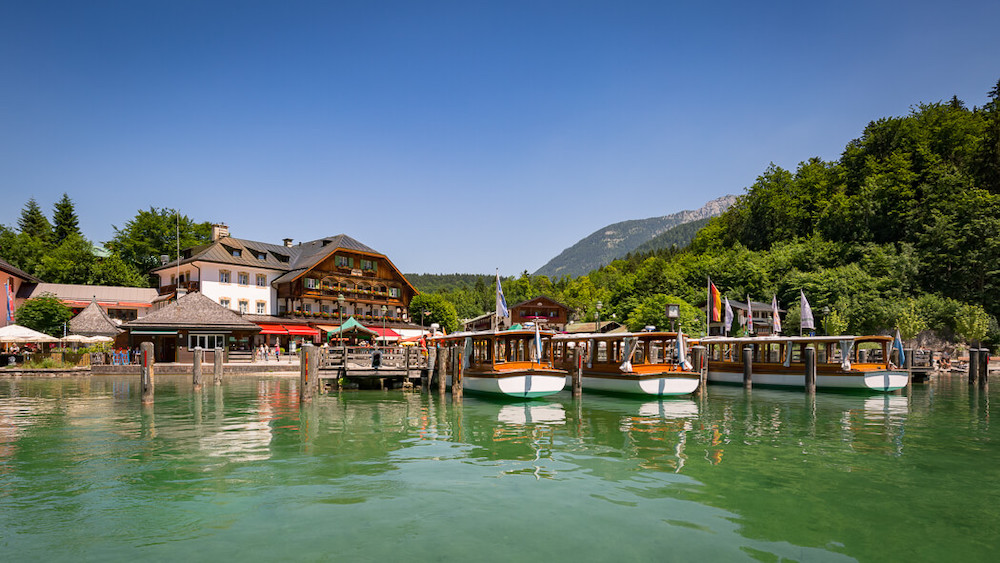
If you’re lucky a boat will be boarding or arriving. Mid to late afternoons in high summer can yield very long return queues that often take in excess of an hour to clear; our recommendation is to start your day as early as possible to avoid this.
15. The Watzmann East Face: King Watzmann and Johann Grill
Once you’ve boarded your return boat, you’ll no doubt have noticed the impressive rock face behind the onion domes of the chapel. The is the east face (Ostwand) of the Watzmann mountain.
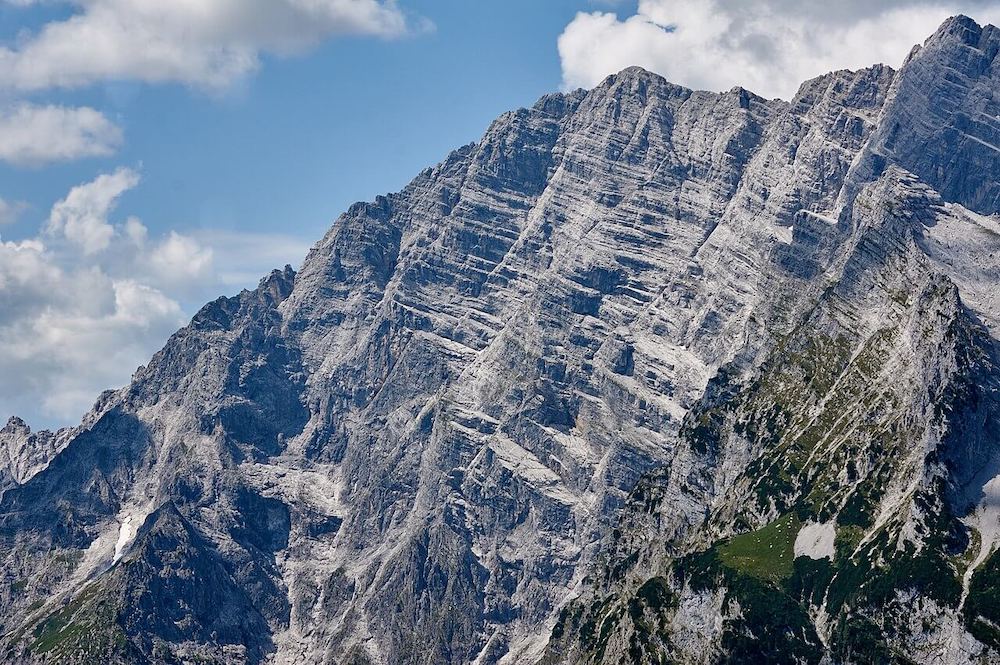
There are in fact three Watzmann peaks; the middle peak (Mittelspitze) at 2713m (8900ft), the southern peak (Südspitze) at 2712m (8897ft) and the high edge (Hocheck) at 2651m (8697ft).
The story of the mountain is an old Berchtesgaden legend.
In ancient times, blood-thirsty King Watzmann is said to have ruled over Berchtesgaden with an iron fist, passing the time by hunting local peasants for sport.
One day, having been particularly wicked, a curse was finally cast upon the king and his family as punishment. The whole family were turned to stone and imprisoned within a range of mountains.
These mountains are those we see today forming the Watzmann range and its sub-peaks, king Watzmann’s wife (Watzmannfrau) and their children (Watzmannkinder).
It was Valentin Stanic from Slovenia who was the first person to climb the Watzmann, making it to the top in 1800. He used the south approach which is considered one of the easiest options and is today used by more than 200 people per day in the summer season.
Much less used is the world-famous eastern wall (Ostwand) of the Watzmann. 1800m of rock towering above the chapel of St Bartholomew makes this one of the best-known rock faces in the Alps – and also one of the deadliest.
The Ostwand was first conquered in 1881 by Johann Grill from Ramsau, near Berchtesgaden. Grill had made a living working as a woodcutter but his passion was the mountains. After his successful ascent of the east face he became something of a mountaineering celebrity and so was able to give up woodcutting to lead expeditions across the Alps.
In 1881 it took Johann Grill 14 hours to complete the east wall for the first time, winding a route up through the many identical ridges of rock.
But for those who know the route, the ascent can be a much faster one. Local experts Philipp Reiter and Martin Schidlowski set the record for the fastest ascent of the east wall in 2015, using their knowledge of the Berchtesgadener Weg to race up the east face in just two hours and three minutes.
Fast changes in conditions and patches of snow into July, however, often catch many experienced climbers out. To date the Watzmann east face has claimed the lives of over 100 climbers.
16. Post-cruise dinner suggestion
Once you’ve got your feet back on dry land why not finish the day’s adventure with some authentic lake side Bavarian cuisine? Watching the sun go down over the mountains on the lake’s shores is simply unmissable.

For a restaurant that combines a stunning lakeside location with authentic Bavarian dishes, head to the Echostüberl at the foot of the Königssee artificial bob and luge track. You can reach this restaurant by following the path left from the boat piers and taking the covered wooden bridge over the Königsseer Ache.
On the lakeside terrace you can sit back and savour the magical view over the Königssee with the shingle-clad boathouses and café Malerwinkl in the background. The menu offers an extensive range of authentic Bavarian dishes, our recommendation is the “Teufelstoast” – the Devil’s toast.
Please note that the Echostüberl is a local favourite and you’ll usually find that many of the tables inside are reserved, especially at the weekend.
